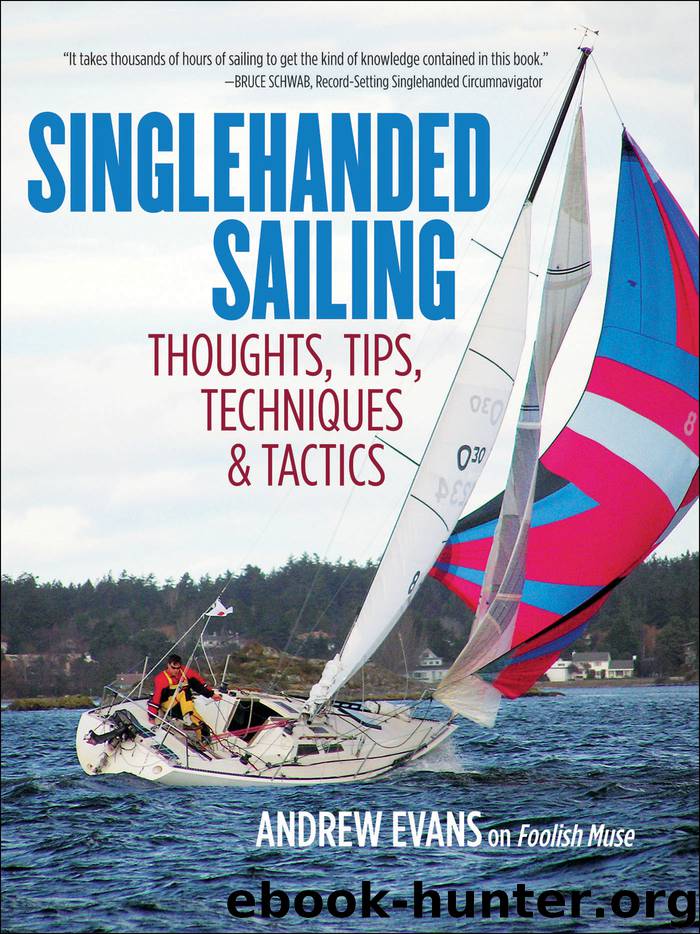Singlehanded Sailing by Andrew Evans

Author:Andrew Evans
Language: eng
Format: epub
Publisher: McGraw-Hill Education
Published: 2015-03-16T04:00:00+00:00
THE SYMMETRICAL SPINNAKER
There is absolutely no reason why a singlehander should not use a spinnaker as aggressively as a fully crewed boat. One of the greatest compliments I’ve ever received came after a very-high-wind race. The skipper of another boat said, “We weren’t going to raise the chute until one of the crew pointed out that you had.” I’ve been asked under what conditions I’ll raise a chute, and I answered, “If I’d do it with a crew, I’ll do it alone.”
I also know that a singlehander can raise or douse a spinnaker every bit as fast as a full crew. A singlehander should raise the chute just seconds after rounding a windward mark, and should douse just seconds before the leeward mark. This is why I advise against spinnaker socks: they are unnecessary and cause delays. Likewise I advise against a singlehander raising or dousing into the forward hatch, which works with a crewed boat because there is someone up there to do it. A singlehander would have to run to the foredeck, douse, then run back to the cockpit to turn the boat. Any steps that cause a delay should be eliminated. I have worked out a process that is failure proof in all conditions and extremely fast, and that gives me total control of the sail and the boat at all times.
I also recommend tying the spinnaker sheets to the clews with a simple bowline knot. Quick-release shackles are common on large crewed boats, allowing the guy to be released from the foredeck, but a singlehander will not be on the foredeck. Any other type of clip is prone to releasing on its own. A bowline has never failed me.
Using the method described below does not put undue strain on the auto-steering system. It is more important that the skipper concentrate on raising and trimming the chute than worry about the tiller. However, if he doesn’t follow these steps the auto steering system will be challenged beyond its limits. Activate the autopilot with three quarters of maximum responsiveness.
1. Packing the chute is vital. This is the leading cause of later problems. Start at the head and run the right hand down the green tape on the starboard side of the sail. It is important to use the right hand on the green tape.
2. Start at the head again and run the left hand down the red tape on the port side of the sail. Now the skipper knows that there are no twists in the sail.
3. Push the sail into the sail bag with the green tape on the right and red tape on the left, and leave the three corners on top of the pile.
4. The best launching position is from the lifelines, just at the forward end of the cockpit on the leeward side of the boat. The skipper wants to be able to work with the sail while standing in the cockpit. Clip the sail bag to the lifelines, making sure that the red
Download
This site does not store any files on its server. We only index and link to content provided by other sites. Please contact the content providers to delete copyright contents if any and email us, we'll remove relevant links or contents immediately.
The River by Peter Heller(2208)
Breath by James Nestor;(2193)
Deep by James Nestor(2110)
Fatal Storm by Rob Mundle(2106)
Sea Survival Handbook by Keith Colwell(2080)
Lonely Planet Australia by Lonely Planet(2002)
Iced In by Chris Turney(1903)
Discover Australia by Lonely Planet(1874)
Lonely Planet Maldives (Travel Guide) by Planet Lonely & Masters Tom(1767)
Looking for a Ship by John McPhee(1608)
One Girl One Dream by Dekker Laura(1597)
Ten Degrees of Reckoning: The True Story of a Family's Love and the Will to Survive by Hester Rumberg(1578)
Chicken Soup for the Ocean Lover's Soul by Jack Canfield(1575)
Lonely Planet Australia (Travel Guide) by Lonely Planet & Lonely Planet(1530)
South with the Sun by Lynne Cox(1490)
The Wave In Pursuit of the Rogues, Freaks and Giants of the Ocean(1450)
Diver Down by Michael Ange(1443)
Marlinspike Sailor's Arts and Crafts by Barbara Merry(1429)
The Golden Rules: 10 Steps to World-Class Excellence in Your Life and Work by Bob Bowman & Charles Butler(1406)
